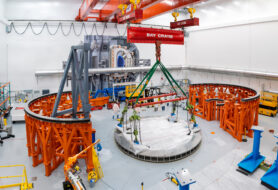There’s a new fusion company building a machine in the land down under, and it’s just notched a milestone on its way to generating fusion power.
OpenStar, a New Zealand startup developing a levitated dipole fusion machine, announced Tuesday that it had achieved first plasma in a test that sustained temperatures of 300,000°C for 20 seconds. The two-year-old company spent less than $10M to get to this point, and now it’s looking to the next phase of iteration and testing for its unusual fusion concept.
I can fly! The levitated dipole design of a fusion machine takes its inspiration from nature.
“The dipole plasma is inspired by the magnetospheres around our planets. Earth has a big dipole plasma around it right now,” OpenStar CEO Ratu Mataira told Ignition. “We already owe our existence to the stability and longevity of dipole plasmas.”
The innate stability of a dipole plasma inspired the levitated dipole design, which essentially looks like an inside-out tokamak.
- A superconducting magnetic core, suspended in the air with a magnetic force, maintains an external plasma in a vacuum chamber.
- This eliminates a lot of the need for complex algorithms and advanced tech to maintain plasma stability.
- However, it requires that the energy source for the machine can live aboard the levitating component, unattached to the walls of the vacuum chamber.
The white whale: Much ink has been spilled and capital invested in the hunt for a company that can finally generate fusion power at commercial scale. Though OpenStar’s approach adds significant technical complexity to the power source problem, the company believes that the design’s allowance for cheaper iteration and improvement will help over time.
“The dipole, of all the magneto-confinement schemes, is by far the most loosely coupled system,” Mataira said. “If you think about the vacuum chambers, the heating systems, the diagnostics, the magnets themselves, the subsystems for breeding blankets, all of them can be treated as actually quite separate engineering problems that don’t cause problems for each other.”
What’s next? The plasma that the company achieved last month was a “minimum viable plasma,” Mataira said, but not the “full rated magnetic field of the magnet that we designed.” Next steps include kicking that magnet into higher gear to gather more data, as well as working out some of the other systems.
- That includes the levitation piece, which the team is confident they’ll be testing in the first few months of 2025.
Next up, OpenStar will finalize the design for its next test machine and raise a round to make that happen. It’s also considering partnership opportunities and a base in the US for its next iteration.
Lead Reporter of Ignition





